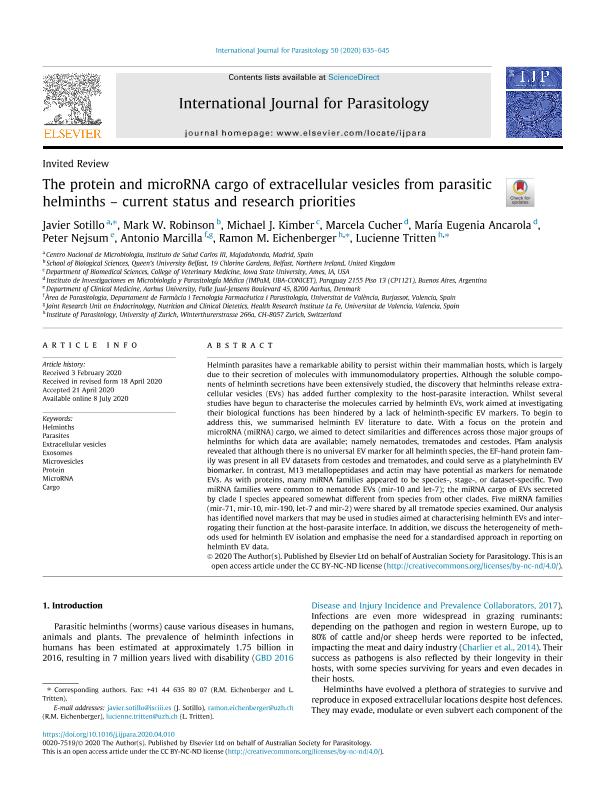Artículo
The protein and microRNA cargo of extracellular vesicles from parasitic helminths – current status and research priorities
Sotillo, Javier; Robinson, Mark W.; Kimber, Michael J.; Cucher, Marcela Alejandra ; Ancarola, María Eugenia
; Ancarola, María Eugenia ; Nejsum, Peter; Marcilla, Antonio; Eichenberger, Ramon M.; Tritten, Lucienne
; Nejsum, Peter; Marcilla, Antonio; Eichenberger, Ramon M.; Tritten, Lucienne
 ; Ancarola, María Eugenia
; Ancarola, María Eugenia ; Nejsum, Peter; Marcilla, Antonio; Eichenberger, Ramon M.; Tritten, Lucienne
; Nejsum, Peter; Marcilla, Antonio; Eichenberger, Ramon M.; Tritten, Lucienne
Fecha de publicación:
08/2020
Editorial:
Elsevier
Revista:
International Journal for Parasitology
ISSN:
0020-7519
Idioma:
Inglés
Tipo de recurso:
Artículo publicado
Clasificación temática:
Resumen
Helminth parasites have a remarkable ability to persist within their mammalian hosts, which is largely due to their secretion of molecules with immunomodulatory properties. Although the soluble components of helminth secretions have been extensively studied, the discovery that helminths release extracellular vesicles (EVs) has added further complexity to the host-parasite interaction. Whilst several studies have begun to characterise the molecules carried by helminth EVs, work aimed at investigating their biological functions has been hindered by a lack of helminth-specific EV markers. To begin to address this, we summarised helminth EV literature to date. With a focus on the protein and microRNA (miRNA) cargo, we aimed to detect similarities and differences across those major groups of helminths for which data are available; namely nematodes, trematodes and cestodes. Pfam analysis revealed that although there is no universal EV marker for all helminth species, the EF-hand protein family was present in all EV datasets from cestodes and trematodes, and could serve as a platyhelminth EV biomarker. In contrast, M13 metallopeptidases and actin may have potential as markers for nematode EVs. As with proteins, many miRNA families appeared to be species-, stage-, or dataset-specific. Two miRNA families were common to nematode EVs (mir-10 and let-7); the miRNA cargo of EVs secreted by clade I species appeared somewhat different from species from other clades. Five miRNA families (mir-71, mir-10, mir-190, let-7 and mir-2) were shared by all trematode species examined. Our analysis has identified novel markers that may be used in studies aimed at characterising helminth EVs and interrogating their function at the host-parasite interface. In addition, we discuss the heterogeneity of methods used for helminth EV isolation and emphasise the need for a standardised approach in reporting on helminth EV data.
Archivos asociados
Licencia
Identificadores
Colecciones
Articulos(IMPAM)
Articulos de INSTITUTO DE INVESTIGACIONES EN MICROBIOLOGIA Y PARASITOLOGIA MEDICA
Articulos de INSTITUTO DE INVESTIGACIONES EN MICROBIOLOGIA Y PARASITOLOGIA MEDICA
Citación
Sotillo, Javier; Robinson, Mark W.; Kimber, Michael J.; Cucher, Marcela Alejandra; Ancarola, María Eugenia; et al.; The protein and microRNA cargo of extracellular vesicles from parasitic helminths – current status and research priorities; Elsevier; International Journal for Parasitology; 50; 9; 8-2020; 635-645
Compartir
Altmétricas



